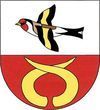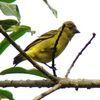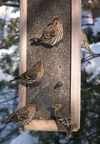Genus Carduelis

Black-capped Siskin - The Black-Capped Siskin is a species of finch in the Fringillidae family. It is found in Guatemala and Mexico. Its natural habitats are subtropical or tropical moist montanes and heavily degraded former forest.
Linnet - This bird breeds in Europe, western Asia and north Africa. It is partially resident, but many eastern and northern birds migrate further south in the breeding range or move to the coasts.
European Goldfinch - The goldfinch breeds across Europe, North Africa, and western and central Asia, in open, partially wooded lowlands. It is resident in the milder west of its range, but migrates from colder regions. It will also make local movements, even in the west, to escape bad weather. It has been introduced to many areas of the world .
Greenfinch - The European Greenfinch, or just Greenfinch, Carduelis chloris, is a small passerine bird in the finch family Fringillidae. The genus Carduelis might be split up and in this case, the greenfinches would be separated in their old genus Chloris again.
Citril Finch - The Citril Finch is a small songbird, a member of the true finch family Fringillidae. For a long time, this cardueline finch was placed in the genus Serinus, but it is apparently very closely related to the European Goldfinch .
Carduelis corsicana - It was formerly regarded a subspecies of the Citril Finch, but it differs in morphology and vocalizations as well as mtDNA sequence and they are now considered distinct species . Formerly, both were placed in the genus Serinus, but they appear to be close relatives of the European Goldfinch .
Thick-billed Siskin - The Thick-billed Siskin is a species of finch in the Fringillidae family. It is found in Argentina, Bolivia, Chile, and Peru. Its natural habitats are subtropical or tropical moist montanes and subtropical or tropical high-altitude shrubland.
Red Siskin - Some hope has been given to this highly endangered species by the discovery in 2003 of a population of several thousand birds in southern Guyana, 1000 km from any previously known colony. Otherwise the world population is believed to be between 600-6000 pairs.
Antillean Siskin - The Antillean Siskin is a species of finch in the Fringillidae family. It is found in the Dominican Republic and Haiti. Its natural habitats are subtropical or tropical moist montanes and heavily degraded former forest.
Common Redpoll - The Mealy Redpoll is larger and paler than the Lesser Redpoll with which it often mixes, apparently without significant interbreeding though sympatry was established too recently to draw firm conclusions.
Twite - The Twite is a small finch, similar in size and shape to a Linnet. Birds of the subspecies flavirostris are 13 to 13.5 centimetres long, and those of the subspecies altaica are 13 to 13.5 centimetres long. It lacks the red head patch and breast shown by the Linnet and the redpolls. It is brown streaked with black above, with a pink rump. The underparts buff to whitish, streaked with brown. The conical bill is yellow in winter and grey in summer. The call is a distinctive "twit", from which its and the song contains fast trills and twitters.
Hoary Redpoll - The Greenland race is a very large and pale bird, with the male sometimes described as a "snowball", but both forms are pale with small beaks, white rumps and often more yellow than grey-brown tones in their plumage. The females are more streaked on their breasts, sides and rumps, but are still pale.
Warsangli Linnet - The Warsangli Linnet is a species of finch in the Fringillidae family. It is found only in Somalia. Its natural habitats are subtropical or tropical dry forests and subtropical or tropical high-altitude shrubland. It is threatened by habitat loss.
Lawrence's goldfinch - At about 4.75 inches long and weighing about 0.4 oz , it is slightly bigger than the Lesser Goldfinch and slightly smaller than the American Goldfinch, with less yellow in the plumage than either. Adults of both sexes are gray with pink to grayish flesh-color bills, stubbier than other goldfinches'. They have yellow rumps and paired yellowish wing-bars, as well as yellow edges on the flight feathers and yellow on the breast. The tail is black, crossed by a white band . Plumage is duller in winter, brightening after a spring molt . Males are paler, with black caps and faces and larger areas of brighter yellow. Females are browner, have less and duller yellow, and lack the black . Juveniles resemble females but are even duller and have faint streaks on the upperparts and especially the underparts .
Hooded Siskin - The Hooded Siskin is a small passerine bird in the finch family , native to South America. It belongs to the putative clade of Neotropical siskins in the genus Carduelis sensu stricto.
Black-headed siskin - This species is considered the extant "father" of the South American siskin radiation.
Pine Siskin - Adults are brown on the upperparts and pale on the underparts, with heavy streaking throughout. They have a short forked tail. They have yellow patches in their wings and tail, not always visible; otherwise, it appears to be a very small streaked sparrow.
Lesser goldfinch - The Lesser Goldfinch or Dark-backed Goldfinch is a very small songbird of the Americas. Together with its relatives the American Goldfinch and Lawrence's Goldfinch, it forms the American goldfinches clade in the genus Carduelis sensu stricto.
Saffron Siskin - The Saffron Siskin is a species of finch in the Fringillidae family. It is found in Ecuador and Peru. Its natural habitats are subtropical or tropical dry forests, subtropical or tropical dry shrubland, and urban areas. It is threatened by habitat loss.
Oriental goldfinch - It nests in trees or bushes, laying 3-5 eggs.
Andean Siskin - Its natural habitats are subtropical or tropical moist montane forests, subtropical or tropical high-altitude shrubland, subtropical or tropical high-altitude grassland, and heavily degraded former forest.
Black-headed Greenfinch - It is found in Afghanistan, Bhutan, China, India, Myanmar, Nepal, Pakistan, Thailand, and Vietnam. Its natural habitats are temperate forests and temperate shrubland.
Siskin - This bird breeds across northern temperate Europe and into Russia. There is a separate population in eastern Asia. It is partially resident, but the northern breeders migrate further south in Europe in the winter. The eastern Asian birds winter in China or further south. In some years there are large eruptions into the wintering range, when the preferred food of alder or birch seed fails. This species will form large flocks outside the breeding season, often mixed with redpolls.
American Goldfinch - The American Goldfinch , also known as the Eastern Goldfinch and Wild Canary, is a North American bird in the finch family. It is migratory, ranging from southern Canada to North Carolina during the breeding season, and from just south of the Canadian border to Mexico during the winter.
Yellow-bellied Siskin - The Yellow-bellied Siskin breeds in mountain oak forests at altitudes between 800–3000 m. The nest is a shallow cup of rootlets, bark, and lichen 2.4–3.7 m high in the dense foliage of a small tree in a clearing. The two or three green-tinged white eggs are laid in April or May and incubated by the female. Although not migratory, this species wanders within its range when not breeding.
Yellow-faced Siskin - Its natural habitats are subtropical or tropical moist mountains, subtropical or tropical dry shrubland, arable land, plantations , and urban areas.
Yemen Linnet - The Yemen Linnet is a species of finch in the Fringillidae family. It is found in Saudi Arabia and Yemen. Its natural habitat is subtropical or tropical dry shrubland.














